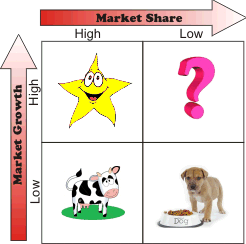BCG matrix
The BCG matrix created by Boston Consulting Group (a management consultancy firm) in 1970 to help corporations with analyzing their business units or product lines.
This helps the company allocate resources and is used as an analytical tool in brand marketing, product management, strategic management, and portfolio analysis.
To use the chart, analysts plot a scatter graph to rank the business units (or products) on the basis of their relative market shares and growth rates.

Cash cows
Cash cows are units with high market share in a slow-growing industry.
These units typically generate cash in excess of the amount of cash needed to maintain the business. They are regarded as staid and boring, in a "mature" market, and every corporation would be thrilled to own as many as possible. They are to be "milked" continuously with as little investment as possible, since such investment would be wasted in an industry with low growth.
Dogs
Dogs, are units with low market share in a mature, slow-growing industry.
These units typically "break even", generating barely enough cash to maintain the business's market share. Though owning a break-even unit provides the social benefit of providing jobs and possible synergies that assist other business units, from an accounting point of view such a unit is worthless, not generating cash for the company. They depress a profitable company's return on assets ratio, used by many investors to judge how well a company is being managed. Dogs, it is thought, should be sold off.
Question marks
Question marks, are units with low market share in a rapidly growing market.
Question marks (also known as problem child) are growing rapidly and thus consume large amounts of cash, but because they have low market shares they do not generate much cash. The result is a large net cash consumption. A question mark has the potential to gain market share and become a star, and eventually a cash cow when the market growth slows. If the question mark does not succeed in becoming the market leader, then after perhaps years of cash consumption it will degenerate into a dog when the market growth declines. Question marks must be analyzed carefully in order to determine whether they are worth the investment required to grow market share.
Stars
Stars are units with a high market share in a fast-growing industry.
The hope is that stars become the next cash cows. Sustaining the business unit's market leadership may require extra cash, but this is worthwhile if that's what it takes for the unit to remain a leader. When growth slows, stars become cash cows and if they are not able to maintian their growth they become a dog.
There are typically four different strategies to apply:
Build Market Share: Make further investments (for example, to maintain Star status, or turn a Question Mark into a Star)
Hold: Maintain the status quo (do nothing)
Harvest: Reduce the investment (enjoy positive cash flow and maximize profits from a Star or Cash Cow)
Divest: For example, get rid of the Dogs, and use the capital to invest in Stars and some Question Marks.
BCG Matrix | |||
|---|---|---|---|
Stars | Cash Cows | Question Marks | Dogs |
| High growth High share | Low growth High share | High growth Low share | Low growth Low share |
| Business is likely to generate enough cash to be self sustaining. | Business can be used to support other business units. | Business requires a lot of cash to maintain market share. | Business is a cash trap. |
Recommended tactics | |||
promote aggressively expand your product or service invest in R & D | defend & maintain | invest more cash or, divest | focus on short term avoid risky project limited future |
![]()



